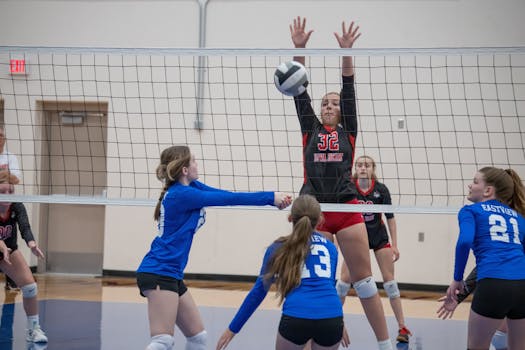Volleyball is a game of strategy, agility, and teamwork. While offensive plays often steal the spotlight, a solid defense is the foundation upon which championship teams are built.
Mastering court defensive techniques through volleyball defense drills is crucial for any volleyball team aspiring to reach the pinnacle of success.

As a coach, I’ve witnessed firsthand the transformative power of well-designed defense drills. They not only hone individual skills but also foster a collective mindset of anticipation, communication, and unwavering determination. In this comprehensive guide, we’ll look into the art of volleyball defense, exploring drills that will elevate your team’s court defense abilities and instill a relentless defensive mentality.
The Importance of Defense in Volleyball
Before we look into the drills, let’s appreciate the important role defense plays in the game of volleyball. A good defense can disrupt the opponent’s offensive rhythm, create scoring opportunities through well-timed digs and blocks, and ultimately outplayed even the most potent attacking teams.
Effective court defense is the cornerstone of a strong defensive unit. It involves positioning players strategically, anticipating the trajectory of the ball, and executing seamless transitions between defensive formations.
By mastering these techniques, your team will become a formidable team on the court, capable of outplaying even the most challenging offensive plays.
Volleyball Defense Drills
Volleyball defense drills are:
- Warm-up and Conditioning Drills
- Reaction Drill
- Digging and Passing Drills
- Blocking and Transition Drills
- Game-Situation Drills
- 6 vs. 6 Defensive Drill
Warm-up and Conditioning Drills – Volleyball Defense Drills
Lateral Shuffle Drill
Agility and quick lateral movement are essential for effective court coverage. The lateral shuffle drill trains players to move swiftly from side to side while maintaining a low, defensive stance.
Instructions:
1. Set up cones or markers on the court, spaced approximately 10-15 feet apart.
2. Players line up at one end and shuffle laterally from cone to cone, maintaining a low, athletic stance.
3. Emphasize quick footwork, keeping the body low, and maintaining balance throughout the movement.
Reaction Drill – Volleyball Defense Drills

Developing quick reflexes and anticipation skills is crucial for successful defense. The reaction drill challenges players to respond rapidly to various stimuli, simulating game-like situations.
Instructions:
1. Players form a circle with one player in the center.
2. The coach or a designated player calls out commands or tosses a ball in different directions.
3. The players in the circle must react quickly by moving to the designated spot or diving to retrieve the ball.
Digging and Passing Drills – Volleyball Defense Drills
Forearm Passing Gauntlet
Consistent and accurate passing is the foundation of a strong defensive system. The forearm passing gauntlet drill reinforces proper passing technique while simulating game-like pressure.
Instructions:
1. Set up a line of players spaced evenly across the court.
2. The coach or a designated player hits balls to each player in the line, varying the speed and trajectory.
3. Players must move to the ball and execute a proper forearm pass to a designated target area.
Diving Dig Drill – Volleyball Defense Drills
In volleyball, diving for balls is often the difference between winning and losing a rally. The diving dig drill trains players to fearlessly commit to digging balls while developing proper technique.
Instructions:
1. Players form two lines on opposite sides of the court.
2. The coach or a designated player hits balls to various spots on the court.
3. Players from each line take turns diving to dig the ball, focusing on proper form and technique.
Blocking and Transition Drills – Volleyball Defense Drills
Blocking Footwork Drill
Effective blocking requires precise footwork and timing. The blocking footwork drill reinforces proper movement patterns and positioning for successful blocks.
Instructions:
1. Set up a line of players at the net.
2. The coach or a designated player tosses balls to different spots along the net.
3. Players must move quickly to the designated spot, execute proper blocking footwork, and simulate a block.
See also:
- Volleyball Block Drills 2024 – New Improved
- Volleyball Hitting Drills – 2024 (New Improved)
- Volleyball Hitting Drills – 2024 (New Improved)
Transition Drill
Seamless transitions between offensive and defensive formations are crucial for maintaining court coverage. The transition drill trains players to quickly shift between these formations.
Instructions:
1. Players start in an offensive formation, simulating an attack.
2. After the attack, they must quickly transition into a defensive formation, covering their assigned areas.
3. The coach or a designated player hits balls to various spots on the court, forcing players to move and execute defensive plays.
Game-Situation Drills- Volleyball Defense Drills
Scramble Drill
The scramble drill simulates game-like scenarios where players must work together to keep the ball in play, testing their court coverage skills and communication.
Instructions:
1. Divide the team into two groups, with one group on offense and the other on defense.
2. The offensive team attacks, and the defensive team must scramble to keep the ball in play.
3. After a set number of rallies, switch the roles of the teams.
6 vs. 6 Defensive Drill
This drill replicates game situations, allowing players to apply their defensive skills in a controlled environment while emphasizing communication and teamwork.
Instructions:
1. Divide the team into two groups of six players each.
2. One team starts on offense, while the other team focuses on defensive court coverage.
3. The offensive team attacks, and the defensive team must work together to defend and transition to offense.
FAQs
How often should defense drills be incorporated into practice?
Defense drills should be a regular part of your practice routine. Allocate dedicated time for defensive work in every practice session, as consistent repetition is key to mastering court coverage techniques.
How can I motivate players to embrace defensive drills?
Emphasize the importance of defense in winning games. Highlight successful defensive plays from professional matches and celebrate defensive efforts during practice. Foster a culture where defensive prowess is valued and celebrated.
How do I ensure proper technique during defense drills?
Provide clear demonstrations and break down the drills into smaller components. Offer individual feedback and make corrections as needed. Encourage players to focus on proper form and technique before increasing the intensity or complexity of the drills.
How can I incorporate game-like pressure during defense drills?
Introduce competitive elements, such as scoring systems or time constraints, to simulate game-like pressure. Use game-situation drills that mimic real match scenarios, forcing players to make quick decisions and execute under pressure.
How do I address individual defensive weaknesses within a team setting?
Identify individual players’ defensive weaknesses and incorporate targeted drills or modifications to address those areas. Provide additional coaching and feedback to help players improve their specific defensive skills.
Final Take (Conclusion)
Mastering court defensive techniques through volleyball defense drills is the key to building a formidable volleyball team.
By practicing the drills outlined in this guide, you’ll not only enhance individual defensive skills but also foster a collective mindset of anticipation, communication, and unwavering determination.
Remember, defense is not just about reacting to the opponent’s offense; it’s about proactively controlling the court and dictating the pace of the game. Embrace the defensive mindset, and your team will become a force to be reckoned with, capable of outplaying even the most potent offensive threats.
Consistency, dedication, and a relentless pursuit of defensive excellence will separate your team from the competition. Commit to mastering these court defensive techniques, and watch as your team’s defensive prowess becomes a source of pride and a catalyst for victory.
See Also:
- Grass Volleyball Rules 2024: A Comprehensive Guide for Players
- Beach Volleyball Rules 2024: Key Differences From Indoor Game
- Middle School Volleyball Rules (2024 Updated)




